Massey Bodies with Independents
Massey Bodies with Independents
Readers who have read Phil Thoms' excellent book on Massey Bros of Wigan will have noticed that well over 90% of Massey output, particularly in the post-war period, was destined for municipal operators.
After the 1948 nationalisation, the remainder went almost exclusively to independent operators, the exceptions being 10 which were exported to Rhodesia and Mozambique, and 2 which were delivered to Eastern National, although even these had been ordered by an independent, Moore's of Kelvedon, before being taken over.
This gallery showcases my own collection of photos of these independents' buses. It is arranged in geographical order, working basically from north to south.
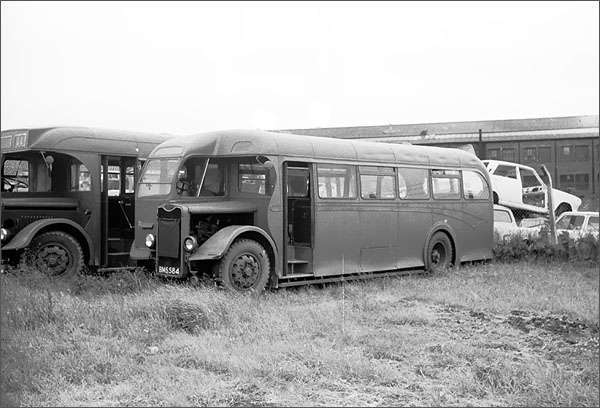
Alexander (Fife) FG32 (BMS 584)
Guy Arab III Massey DP35F 1946
Aberhill Garage, Methil, Fife
6th July 1967
We start in Scotland. Between 1946 and 1948 Alexanders bought 20 single deck buses with Massey bodies, as the Alexander factory was busy with sub-contract work for Leyland. This one became Fife FG52, and is seen after withdrawal painted grey, as was the habit of this operator with vehicles waiting for disposal.
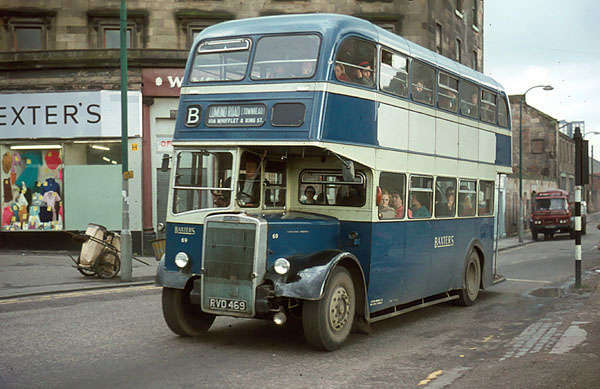
Baxter's Bus Services, Airdrie 69 (RVD 469)
Leyland Titan PD2/40 Massey L27/28R 1958
Coatbridge Fountain,
18 September 1970
To the east of Glasgow, the towns of Airdrie and Coatbridge were served by Baxter's Bus Services. This operator had been taken over by Eastern Scottish in 1963 but the identity continued in use until 1977. Baxter's were a regular customer of Massey, taking 21 double-deckers on mainly Leyland chassis between 1954 and 1962. It was the largest number with any independent operator.
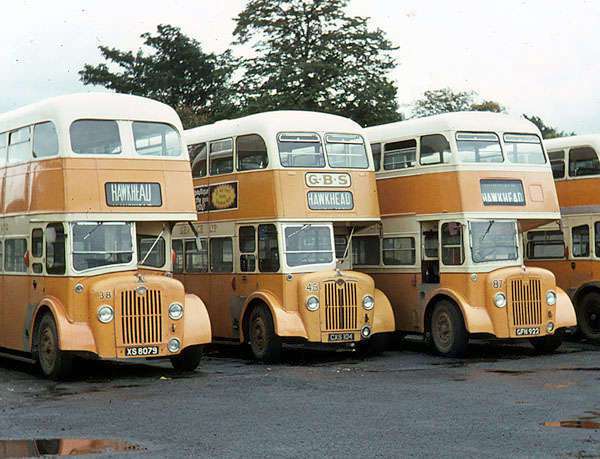
Graham's Bus Service, Paisley 45 (CXS 104) (centre)
Guy Arab IV Massey H33/28R 1959
Also 38 (XS 8079 Guy Arab IV NCME H30/26R 1953 (left)
87 (GFN 922) Park Royal H58RD 1953 (ex East Kent 922)
Hawkhead Garage, Paisley
17 September 1970
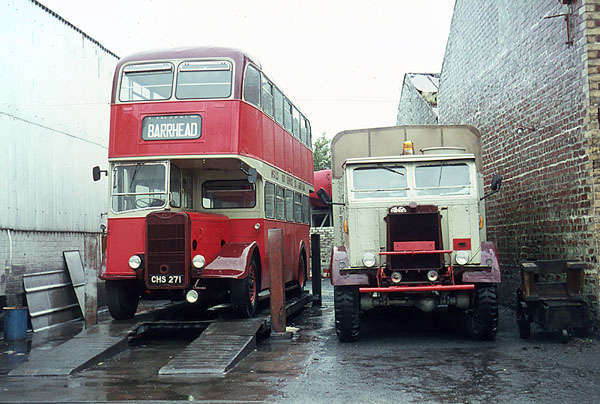
McGill's Bus Service, Barrhead CHS 271
Guy Arab II (1944) Massey H30/26R 1955
McGill's Garage, Barrhead
17 September 1970
Moving west to Paisley, two of the several local independents bought Massey bodies. Graham's bought just the single example on their favoured choice of Guy Arab chassis, which came both new and second hand. McGill's, of Barrhead, first patronised Massey in 1955 when 4 Guy Arab II chassis were rebodied, of which CHS 271 was the last survivor. McGill's also chose Massey for a Leyland PD2/30 in 1958 and two Daimler CVG6s in 1959.
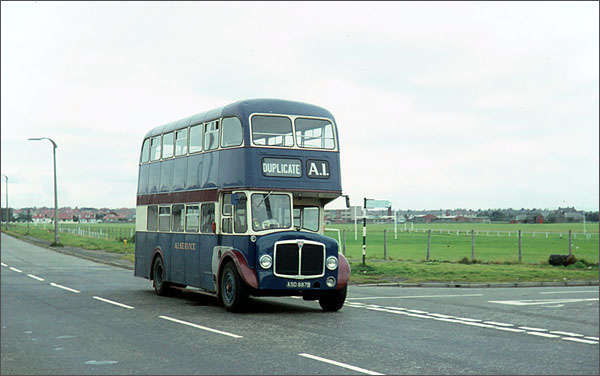
A.1. Services, Ardrossan
ASD 887B (J Stewart, Stevenston)
AEC Regent V MD3RV 2D2RA Massey H37/28RD 1964
High Road, Ardrossan (at Sorbie Rd), 16 September 1970

A.1. Services, Ardrossan
AAG 312B (Brown, Dreghorn)
Daimler Fleetline CRG6LX Massey H43/31F 1964
High Street, Irvine (at The Cross), 16 September 1970
Travelling southwest to Ayrshire, we encounter the fascinating multi-operator combine, A.1. Services of Ardrossan. I have included two views because of the particular interest of the vehicles involved. The Regent V/Massey combination only appeared in quite limited numbers, with just four going to independents, ASD 887B and 888B to A.1., and earlier two to Baxter's. AAG 312B was the only Daimler Fleetline to receive a Massey body.
Moving on, the northern parts of England were pretty well a desert devoid of Massey products with independents, a remarkable circumstance given the location of the firm. West of the Pennines was an area surprisingly free from independents likely to order double-deckers (nothing went to Lancashire United), while to the east the products of Crossgates were more favoured.

J Fishwick & Sons, Leyland 2
(YTD 951D)
Leyland Tiger Cub PSUC1/12 Massey B45F 1966
Golden Lane Garage, Leyland,
19 May 1971
A small oasis in this desert were Fishwick of Leyland who in 1966 bought a pair of Tiger Cubs. These were the only underfloor-engine buses bodied for a UK independent.
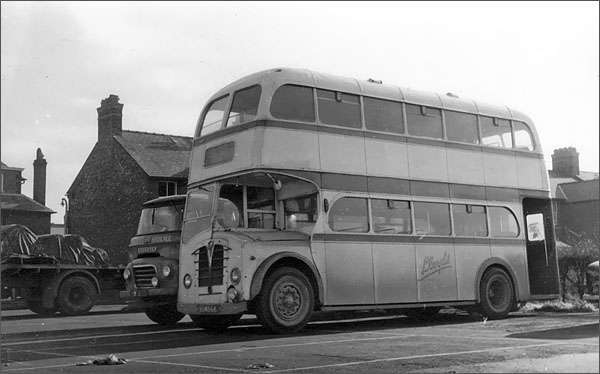
P & O Lloyd, Bagillt FDM 568
Foden PVD6 Massey H30/26R 1949
Flint, 5 March 1966
Our next location is North Wales. P & O Lloyd of Bagillt were unusual in purchasing new double-deck buses, but without operating any regular normal stage carriage routes. Their mainstay was providing staff transport for the various large firms along the Dee estuary. Following the Foden in 1949, three further Massey bodies joined the fleet between 1955 and 1959 on Guy Arab III and Leyland PD3 chassis.
Moving across the North and East Midlands we meet three operators who bought from Massey at some stage.

Turner's, Brown Edge, Staffs. 10
Leyland Titan PD2/37 Massey H37/27F 1964
Turner's Garage, Brown Edge
31 August 1970
The first is Turner's of Brown Edge, one of a group of independents in the Potteries. Between 1957 and 1964 all their intake of new double-deck buses - 2 Leyland PD2s and 2 PD3s - came with Massey bodies. No.10 was the last before Massey were taken over, but they stayed on with NCME bodies, though now on Fleetline chassis.
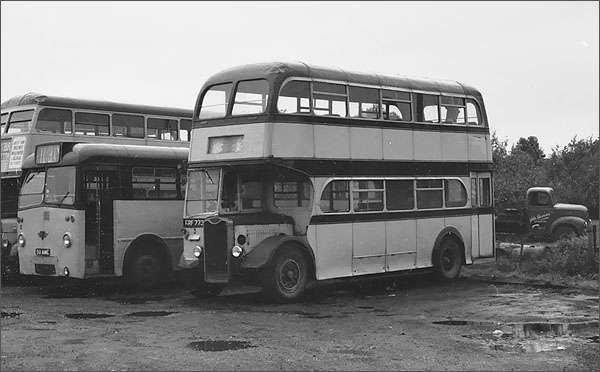
Stevenson, Spath 3 (RRF 773)
Guy Arab III Massey H30/26RD 1949
Stevenson's depot, Spath, Uttoxeter, 15 October 1966
Stevenson's of Spath, near Uttoxeter, were well known for the variety of second-hand stock in the fleet. However in 1947 and 1949 they had bought new respectively a Burlingham bodied Leyland PD1 and this Massey bodied Guy. Originally delivered with a Meadows engine and open platform, it later received a Gardner 5LW unit and platform doors. Stevenson's would not buy another new double-deck bus for another 30-odd years.
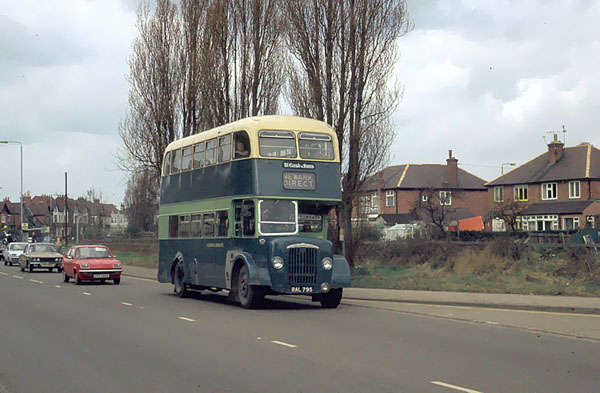
W Gash & Sons, Newark DD10
Daimler CVG6 Massey H33/28RD 1954
Radcliffe Road, West Bridgford,
18 March 1978
The situation at Gash & Sons of Newark was rather similar to that of McGill's, with the bulk of orders being rebodies of older chassis. DD10 was the only new bus from Massey, in 1954, with the rebodies (all on Daimler CVD6 chassis) following in 1958 (3) and 1962 (1). At 24 years of age DD10 was still doing all-day service on Gash's main Newark to Nottingham service.
Cutting back across country we reach South Wales, where two small operators right at the western end of the coalfield bought from Massey. Both were based in the small village of Tycroes near Ammanford.
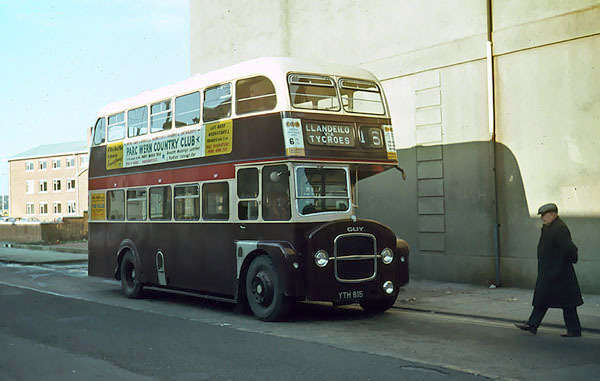
Rees & Williams, Tycroes YTH 815
Guy Arab IV Massey L31/28RD 1962
Llanelli, 24 November 1969
Rees & Williams' main service was between Llandeilo and Llanelli. Between 1948 and 1962 they bought 7 Massey bodies, of which 2 were double-deck and 1 single-deck rebodies; one of the double deck bodies replaced a Massey body bought new 10 years earlier. YTH 815 was the last of the line and unusually sported a Jo'burg style front cowl. It subsequently passed to Warstone Motors (the 'other' Green Bus), before finally becoming a restoration project in Swansea.
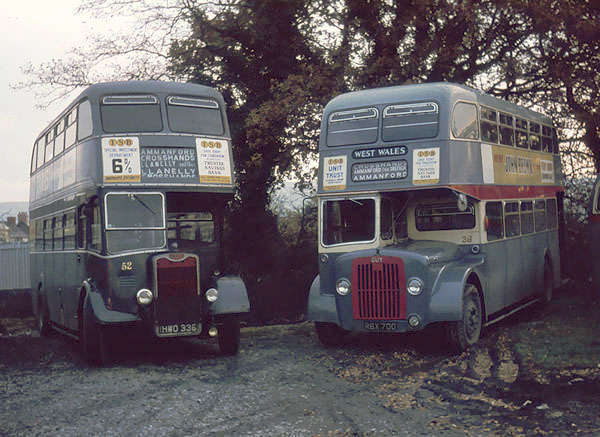
West Wales Motors, Tycroes 39 (RBX 700) (right)
Guy Arab IV Massey L34/33RD 1958
Also (left) 52 (HWO 336) Guy Arab III Duple L27/26RD 1949 (ex Red & White c1967)
Tycroes Garage, 24 November 1969
West Wales Motors purchased just the single Massey bodied Guy from new, although the sister vehicle to the Fishwick Tiger Cub shown above joined the fleet later.

Llynfi Motors, Maesteg 72
(YTG 304)
Leyland Titan PD3/4 Massey H41/31F 1958
Maesteg Garage, 21 April 1979
Moving east from Swansea we find Llynfi Motors of Maesteg, deep in Welsh mining territory. In a mainly second-hand fleet, No.72 was unusual in being a brand new acquisition in 1958. It was still looking smart 21 years later.
The final leg of our journey takes us right across England to Essex. Here we find the only instance of Massey bodies being delivered to a nationalised company, although admittedly they were ordered by an independent.
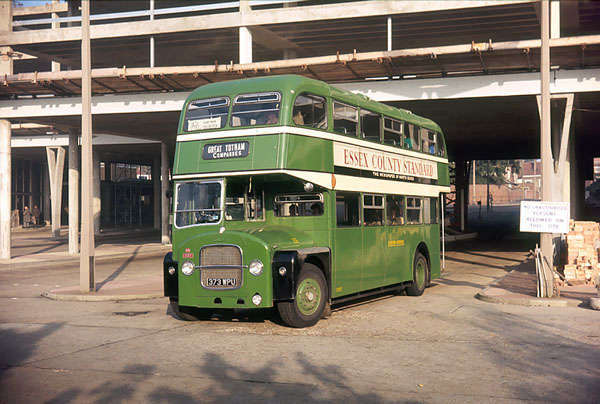
Eastern National 2017 (373 WPU)
Guy Arab IV Massey L34/33R 1961 (ex Moore, Kelvedon 1962)
Colchester Bus Station
24 November 1969
Moore's of Kelvedon ordered 11 double-deck bodies from Massey between 1958 and 1963, the largest number for a single operator after Baxter's. Three in 1960 were rebodies for earlier Guy Arab I, II and III chassis, the remainder all on Guy Arab IV. I never got to Moore's before take-over, so a view of the last of their own deliveries, in Eastern National colours, must suffice. The occasion was a PSVC tour to the area.
When I first thought of creating this gallery, I hadn't appreciated that it would end up with such a good coverage of chassis types, as well as providing a nearly complete overview of Massey's post-war body styles, with even single-deck versions covered. In particular, the black and white selection, which has been lying dormant in comparison to the colour slides, has made a significant contribution.
(Vehicle details taken from Massey Bros Coachbuilders by Phil Thoms (Venture ISBN 978-1905-304-43-1), various British Bus Fleets and PSVC Fleet Histories)
Alan Murray-Rust
04/2013
19/04/13 - 12:13
There's an amazing variety here, Alan, including some view which show what must be either unique or nearly unique combinations. I wasn't aware that the A1 Fleetline was the only one to have a Massey body. It is well-known that very few Foden double deckers were produced, and to find one with both a Massey body and from new with an Independent must surely qualify under 'unique'. Well done!
Pete Davies
19/04/13 - 14:21
Pete D: Surprisingly, the Foden is not quite unique. Phil Thoms' book lists 4 Foden deckers going to independents. The immediate next on Massey's order list was one for next-door neighbour Phillips of Holywell. (There's no indication of whether this might have been a collaboration). The others went to the Scottish CWS (t/a Smith, Barrhead) and Rowbotham, Harriseahead (near Stoke on Trent). Coincidentally, the Stevenson Guy is the next on the Massey list to the Phillips Foden.
Alan Murray-Rust
19/04/13 - 17:18
Nice gallery, Alan.
I was never a great lover of Massey bodies, and preferred the lowbridge version, which avoided the excessively domes fronts. From my point of view, the two Guy Arab IV's are the nicest, Their tin fronts were always my favourite of all the tin fronts. The Eastern National one looks particularly smart.
Who were the particularly big users of Massey - Southend is the main one which I think of.
Incidentally, can anyone identify the military lorry next to the McGill vehicle. It is not a ubiquitous Bedford QL or a Dennis.
Chris Hebbron
20/04/13 - 07:27
I wasn't a great fan of Massey's products but it was another player in the very interesting body building landscape.
I agree with the comments on the Arab IVs, the Jo'Burg tin front was possibly the most stylish of all the attempts at modernising the front engined double decker and the curves matched the curves of the bodybuilder.
Wigan was, of course, a user but the company was always overshadowed by its Northern Counties neighbour and the owner of the company had a very individual approach to sales and who he would supply.
The military truck is an Albion but I can't add anything further.
Phil Blinkhorn
20/04/13 - 07:27
I believe the military lorry beside the McGill's bus is an Albion WD.FT11 3-ton 4x4. They were supplied to the army between May 1942 and August 1944.
John Stringer
20/04/13 - 07:29
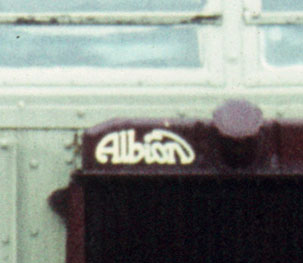
Chris: The McGill recovery vehicle is an Albion. The badge is picked out in white on the radiator header, and the traditional curved shape can just about be made out at this resolution, but here's the unshrunk version.
Far and away the largest customer of Massey in the postwar period was Birkenhead, with well over 200 in the post-war years, followed by Southend (78) and -unsurprisingly - Wigan (53). Other regular customers in reasonable quantity were Exeter, Colchester, Chester and Maidstone.
Alan Murray-Rust
21/04/13 - 18:03
Great Yarmouth was another Massey customer. I have to say that I always liked Massey bodies. The Massey factory was relatively small (apparently, it was once the Wigan and District steam tram shed) turning out about two bodies a week, and the proprietor, Arthur Tyldesley, effectively picked his customers. Some fleet engineers took the view that the Massey metal body frame was the best in the industry. Perhaps the front dome of the double deck could look a little heavy in some colour schemes, but the quality of finish, in and out, was exemplary. No other body builder could match the internal anodised window pans, which could be "gold" if required. In its last years, by which time it had belatedly come round to building on rear engined chassis, Massey bodywork styling changed markedly from the very rounded form to the extremely angular.
Roger Cox
22/04/13 - 07:57
Roger,
Tyldesley was once described to me by a competitor can't remember if it was at East Lancs or Northern Counties) as a 19th century mill owner throw back.
That adds up in terms of both the rather eccentric dealings with customers and the doubtless quality of the product. What "industrial relations" were like in the company can only be guessed at but the designers' ideas certainly went through a dramatic sea change from the curvaceous to the angular.
There were also visual jarrings such as the rear side window on the Fishwick Tiger Cub which is identical to that on similar bodies supplied to Wigan on Panther Cub chassis.
Phil Blinkhorn
22/04/13 - 07:58
Hanson's Buses, Huddersfield had their 1935 highbridge all Leyland TD4 VH 8081 rebodied with a Massey lowbridge body in 1946.
They sold it in 1949. Does anyone know who they sold it too?
Eric Bawden
22/04/13 - 07:59
There was also a link with Pemberton caravans but I can't remember whether Pemberton owned Massey or vice versa.
David Oldfield
22/04/13 - 10:18
Having made a comment on the CIE Titan thread, can I here say that I am not advocating straying into old caravans!
David Oldfield
22/04/13 - 14:38
Nice one David. I had Pemberton Caravans on my territory as a rep in the late 1960s and if I remember correctly the Tyldesley family were the owners.
Phil Blinkhorn
22/04/13 - 18:22
Phil, perhaps the Victorian mill owner mentality came from an ingredient in the Manchester air - Hugh Gardner was another of the ilk. It would seem that the three Massey brothers, William, Isaac and Thomas, started out in 1904 as timber merchants and building contractors. Indeed, housebuilding continued until 1962, so the spin off into caravans and mobile homes (so called!) would have been a logical extension of the timber business. Quite when Arthur Tydesley assumed control I do not know, but as Alan says, there is now a book on Massey by Phil Thoms. I must get a copy. Alan's pictures of the "Johannesburg" bonneted Guys are particularly welcome. To my eye, and probably to those of maintenance minded fleet engineers also, this front was a great improvement on the old Birmingham derived design. Why did Guy offer it for such a brief period before reverting to the older pattern? Where there cost implications in the firm's financially straightened final years?
Roger Cox
23/04/13 - 08:01
Pemberton Caravans as such is listed in Company House Records as being formed in 1955. There may well have been a previous incarnation but the Massey family certainly came from Pemberton. I'm not sure when Arthur assumed control of the bus body builders or if he bought out/bought into the rest of the Massey operation. Like Roger I must get the book.
As regards the Guy Jo'burg tin front it would seem that it was an optional extra available to any customer but production seems to have been limited in the UK market to 1961 and 1962 and one of the company's biggest customers, LUT, never touched it - which may give a clue as to why Jaguar dropped the design after the takeover.
Phil Blinkhorn
23/04/13 - 08:02
Our old friends the N.E.B.P.T. Ltd have a rather nice example of an H30/26R Massey bodied Guy Arab IV. UFJ 292 was new to Exeter Corporation in 1957, and later passed to Shaw Bros of Byers Green in Co Durham, in who's livery it is preserved. Its a regular at shows through out the area, and pictures can be found on the trust site or on Flickr.
Ronnie Hoye
23/04/13 - 08:03
Arthur Tyldesley was Isaac Massey's son-in-law and joined the firm as Managing Director from outside the industry in 1950. Phil Thoms book makes no mention of the Pemberton caravans business, which I am sure he would have if there had been a direct financial link. Picking up on Phil's comment, the implication is that the connection was purely that the Tyldesley family had members in both businesses. On the question of industrial relations - not featured in the book - the fact that the owner may have been autocratic does not necessarily imply a hostile attitude to the workforce.
On the subject of Joburg fronts, I have identified it with the following operators - by no means a definitive list - Chester, Blackburn, Pontypridd, Blue Line (Armthorpe), Graham (Paisley) (ex demonstrator) plus the two Accrington and one Wolverhampton Wulfrunians. I agree with Phil that it was a stylish design, almost up with the AEC grille, which I think has to be considered the best.
Alan Murray-Rust
23/04/13 - 13:52
Thanks Alan for clarifying Arthur Tyldesley's relationship. It would have made perfect sense to keep the businesses in such a diverse range of industries separate.
As to industrial relations, having been brought up in the North West with a grandfather who once had his own sizable business, as I had dealings with many "autocratic" bosses in the days when the term "PC" in either version was unheard of and given remarks passed to me within a few years of Massey's demise as a stand alone business, I would have thought Arthur would have been admired and loathed in equal measure but his word would have been law.
Phil Blinkhorn
25/04/13 - 07:32
Alan, I presume you never intended your article to be exhaustive, since in a later post you did mention three further Massey-bodied Fodens. One Massey-bodied bus which I thought would have perhaps been given a mention was UVA 638, new to Laurie (Chieftain), of Hamilton - one of only five Massey-bodied PD3s new to independents. This particular vehicle later found fame through being involved in a low bridge accident when with a subsequent owner (Rennie's of Dunfermline) and finishing up with an ECW front dome (it may have been an entire roof, I'm not sure now), ex a Bristol Lodekka.
A small number of statements I feel compelled to query.
1) Alexanders - surely not in any way still independent in 1948?
2) Lloyd's of Bagillt - RDM 200 was an Arab IV (not III) and I think the earlier one (MDM something, I think) must have been an Arab IV also.
3) Moore's of Kelvedon - I have only managed to identify eleven, rather than thirteen, Massey bodies ordered by this operator in the period from 1958 (yes, that does include the two delivered to Eastern National). Were two bodies much earlier than 1958, or was the total wrong?
One statement is definitely wrong, that being that the only Massey-bodied Regent Vs supplied to independents were the ones for Baxter's and A1. SVD 676 was new to Greenshields of Salsburgh, passed with the Greenshields business to Irvine's (Golden Eagle), also of Salsburgh, when quite new, and passed again (at a still quite youthful age) to Worth's, of Enstone, Oxfordshire, where it was used (on stage service) for several years.
David Call
27/04/13 - 07:56
There is a pic of UVA 638 (when with Chieftain) at this link
In the pic of the Turner's PD2, one of the PD3s can be seen immediately behind - No.6 (961 GBF)
David Call
27/04/13 - 09:19
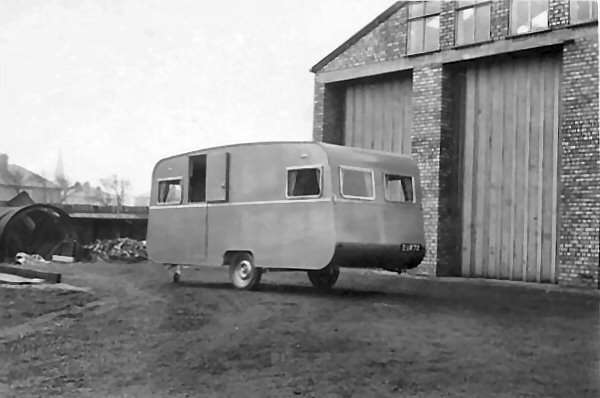
I have just stumbled upon your website and find the photographs and comments extremely interesting.
I had no idea that there was a caravan company owned by the Tyldesleys. However I do have a photograph of a caravan built about 1954/5 standing outside the Massey works, but nobody came forward with any information regarding this apart from it being Arthur Tydesleys and destined for the Lake District.
Phil Thoms
30/04/13 - 05:42
There is a much better shot of UVA 638, when new, on Phil Thoms' quite small, but excellent, Flickr photostream. It's worth a look for some of the other shots.
I am aware that Phil contributes to this forum (see above!) but I can't imagine him objecting to people visiting his Flickr site. The link is here.
David Call
30/04/13 - 09:26
Thx for the link, David C.
On that page, I was also impressed by the 1937 R S & J Ipswich Corporation 68 trolleybus being tilt-tested. It has very handsome Massey bodywork.
Chris Hebbron
02/05/13 - 14:22
David Call:
Many thanks for the corrections. The Lloyds reference is definitely a typo, as I was well aware that the other Guys were Arab IV. The Greenshields Regent clearly missed my eye when looking through the lists in Phil's book, this being my source of reference. (I'm currently a long way away from my library, so can't do a double check at the moment. The Alexander Guy is a bit of a grey area, but is certainly not municipal, and is part of a line of descent which is equivalent to the pre-nationalisation companies in England. It was an excuse to include this particular body style.
As far as comprehensiveness is concerned, it was always intended to my own photographic collection, so there were always bound to be some gaps.
Phil Thoms: I had intended to send you a link to the gallery, but preparations or my trip to foreign parts overtook this!
Alan Murray-Rust
18/05/13 - 16:59
Under the Foden for P&O Lloyd, it states that the company brought new another three new Massey buses on Arab 111 and PD3 chassis. The two Guy Arabs were Arabs 1V.
Glyn Jones
14/02/14 - 08:35
I can't believe that this one has hitherto escaped my usual critical eye. In the caption to Regent V ASD 887B of A1 service it is quoted as being of model MD3RV. In fact this vehicle, and its sister ASD 888B, were actually 2D2RA (AV590 engine, Monocontrol transmission).
The Fishwick depot was, of course, (and still is) located on Golden Hill Lane rather than Golden Lane.
When I mentioned SVD 676 I couldn't find a photograph of it on the internet - there seem to be at least four at the moment. Here's a shot of it with Greenshields and one of it with Worth's.
David Call
07/01/15 - 09:02

Here's a photo of a brand-new Stevenson's RRF 773, which I'm guessing was taken in Pemberton. Can the location be confirmed please? Also, does anyone have a sharper copy of this photograph?
Tim Jeffcoat
05/10/15 - 07:25
Further to my own post of 14/02/14, the address of Fishwick's HQ has in recent years been given as Tuer Street, rather than Golden Hill Lane, but Tuer Street is a very short street, off Golden Hill Lane, leading into the Fishwick depot and nowhere else. The depot is still in the same place.
Does anyone know if the other depot (at Chapel Brow) is still in use? It was built in the early 1960s, I think (when Fishwicks decided to go into coach operation, on the site of (I have always presumed) the ex-Singleton premises.
David Call
06/10/15 - 06:24
David Call's recent comment has a query about the Fishwick depots. Coincidentally, I have just finished reading Bus & Coach Preservation magazine (November issue). In this, Nigel Appleford has an article on models of the Fishwick fleet. He also states that the firm remains at it's birthplace at Golden Hill Lane. He adds that coaches were once kept at Chapel Brow, Leyland, but that coaches are now kept with the buses at Golden Hill Lane. He doesn't mention dates. Unfortunately, there are no models of a Massey-bodies bus with Fishwicks or anyone else!
Michael Hampton
Davd C
I believe this is the site you mean of Hewitt St at the top of Chapel Brow.
According to an article in the local paper from Sept 2014, which said the bus garage had been closed for some time, there is going to be some house building in this area and they are talking about reversing the Chapel Brow one way system (As this was last year all may now be different), https://www.google.co.uk/maps
John Lomas
06/10/15 - 06:27
In the Spring of 1961 JMT (Jersey Motor Transport) had five Leyland Tiger Cubs bodied by Massey. They were unusual in having hardly any rear overhang to help with manoeuvrability on the island's rural roads. http://166emj.piwigo.com/picture?/3964/category/25-jersey_and_guernsey_buses_and_coaches_1964_1968
David Slater
04/07/16 - 07:05
I'm surprised that I do not seem to have responded to Eric B's query of 22/4/13. Here is a shot taken in 1958 at the premises of Paton, Renfrew, showing a Leyland Titan carrying the registration VH 8081. It certainly doesn't have a postwar Massey body (therefore the implication is that it is not the real VH 8081), but the likelihood is that the 'real' VH 8081 did operate for Paton at some point. Click to enlarge. http://thetransportlibrary.co.uk/ link no longer works see below.
David Call
04/07/16 - 16:10
Well David, it looks as if someone has indulged in a bit of numberplate swapping with VH 8081!
When new to Hanson in 1935 it had a Leyland highbridge body. There is a photo of it with its new Massey body on http://www.jsh1949.co.uk
Click on the Illustrated Hanson Fleetlist then scroll down to fleetnumber 75. This same photo also appears in the book "Hanson of Huddersfield and their Neighbours"
Eric Bawden
11/12/21 - 09:03
Here's another link to the 'Transport Library' photo I posted on 04/07/2016, the original link seems to have gone. https://thetransportlibrary.co.uk/
On page 28 of 'Leyland Torque' issue 78 (Winter 2017) it is stated that VH 8081 was fitted with a secondhand Alexander L27/26R body from an unknown source prior to its sale by Baxter's to Paton's, but there is no mention of any body swap in Douglas MacDonald's book on Baxter's, so the situation remains, to me at least, suspect.
David Call
18/12/21 - 08:45
My tale of the Hanson/Paton TD4 VH 8081 seems a bit full of errors and omissions. For starters, as I implied above (but did not expressly state) it operated for Baxter's of Airdrie after Hanson, in fact it did so for most of its time with its Massey body, from 1949 to 1957 - that effectively answers Eric B's query. It was Baxter's first Massey-bodied vehicle.
I stated above that there was no mention of a body swap in Douglas MacDonald's book on Baxter's - it seems there is, in the caption to a photo of the said vehicle, in Baxter's colours, on page 19. However it is stated that the body swap took place after the sale to Paton's, I had previously referred only to the fleet list, where there is indeed no mention of a body swap, but, if the supposed swap didn't occur until it was with Paton's, there wouldn't be.
David Call
26/08/22 - 06:25
Having spent many an hour in recent days/weeks reading several pages of your truly excellent web-site and I must admit it be very interesting and compelling to anyone who has been involved with buses and coaches of the past here in the UK. Realising that the independent sector does not attract the same following as Corporations and suchlike, which incidentally is something I have experienced going way back as it always has been the case. That said I was wondering if you would be interested in some information on the four Massey bodied vehicles of P&O Lloyd in North Wales which were purchased new and all of which gave unquestionable sterling service over very many years. I have noticed many bus/coach web-sites refer to the firm as 'Lloyd's Bagillt' which is the name of the village location. The P&O prefix in the name refers to the original partners who were twin brothers, Pryce and Owen. Owen was my grandfather who had worked as a steam Sentinel lorry driver and volunteered for army service in WW1 driving Foden steamers in France taking shells etc to the front lines and if you could coax him to talk about it told a very intriguing tale of his experiences through the first war. Both he and a couple of his workmates volunteered due to the fact that being experienced steamer drivers they knew that they would be utilised as such and not conscripted for poor cannon fodder, as we all know such as was the case with the majority of those conscripted. Steamer drivers were considered to be 'skilled workers' back in those days and recognised as such so the option seemed the best of a bad situation for him and his work friends. Needless to say it still wasn't an easy option but simply put I might not have been here writing this if he hadn't of chosen it. He drove Sentinels in the main after the war as they were considered as one of the best but had an affinity to the Foden brand hence the firm buying a number of Foden chassis vehicles after WW2. I can remember most of the Fodens in their later years with the firm and as for the two Guy Arab IV's and Leyland PD3/4 amongst many other associated things I drove them in service for many a mile. Lastly for me I read that opinions vary widely on the Massey bodied vehicles but for me they really were top drawer in very many aspects of construction, design, choice of materials and exceptional longevity in service life. I can list a couple of exceptions in construction but we'll save that for another time.
John L Lloyd
Comments regarding the above are more than welcome please get in touch via the 'Contact Page' or by email at obp-admin@nwframpton.com
If you have any bus related photographs that you would like to appear in a gallery on this website please send them to me by email at obp-admin@nwframpton.com
Quick links to - Galleries - Comments - Contact - Home
All rights to the design and layout of this website are reserved
Old Bus Photos from Saturday 25th April 2009 to Wednesday 3rd January 2024